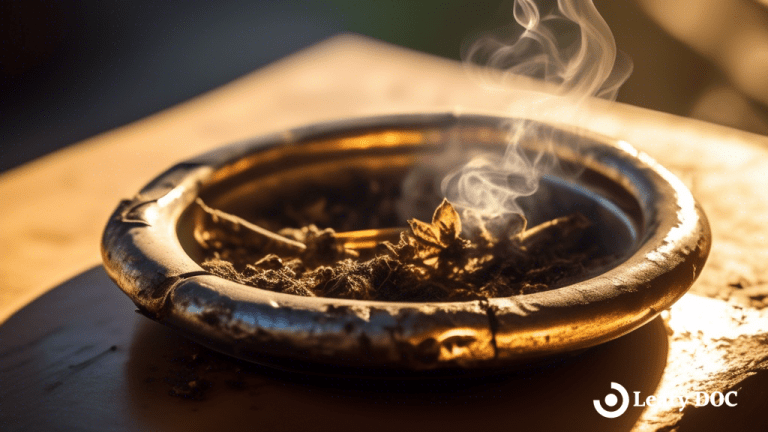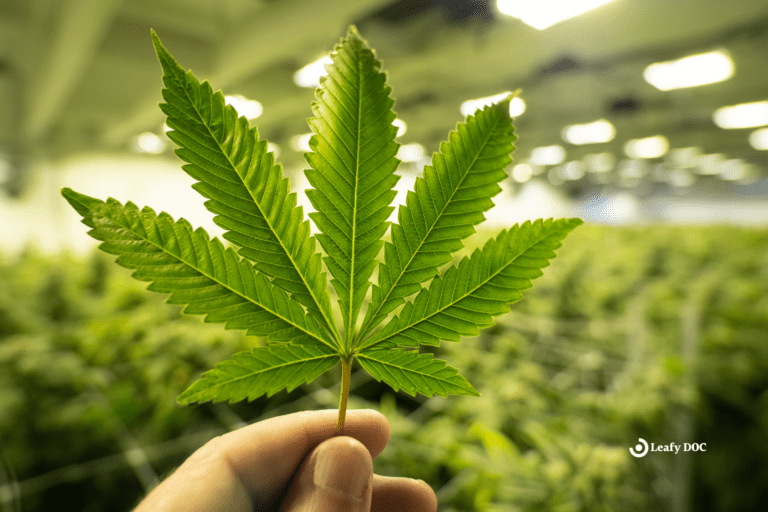How Can I Use Leftover Leaves and Stems?
by Haley Mills · February 8, 2023
Don’t throw away all that marijuana trimming! Learn how to use your leftover leaves and stems to create delicious edibles, make homemade extracts, and more.

Cannabis trimming is vital for cultivating healthy plants and higher yields, but for many home growers, the concern is: What do you do with your trimmed leaves and stems? Read on to learn more.
What is marijuana trimming?
Cannabis trim is removed from cannabis plants after harvesting, including the sugar leaves, fan leaves, and stems. After they have fully grown, cultivators pick and trim the plants with trimmers.
A post-harvest weed trim is to create a better-looking and more potent product by removing leftover plant material. Although trim is not nearly as powerful as buds, it contains some cannabinoids. Cannabis trimmings are typically not smoked due to the harshness and low cannabinoid content, but there are other ways to utilize it.
Sugar Leaves vs. Fan Leaves
There are two main types of cannabis leaves. They are opposite in physical traits and have different uses. Cannabis fan leaves are large and capture light for photosynthesis. They are the iconic marijuana leaf, though they are usually discarded once trimmed because they do not produce resin. Sugar leaves are smaller than fan leaves and make quite a bit of resin. The buds are formed in these leaves and can be saved after trimming for pre-rolls, extracts, or concentrates.
The Basics of Cannabis Leaves
Now that you know the types of cannabis plants identifying your plant and understanding its needs through the cannabis leaves will ensure you grow healthy plants after the seedling stage.
The Indica leaf is short and broad, producing seven and nine vast leaflets along the plant stem. Indica-dominant strains usually have a bush-like appearance with chunky and wide leaves. The Indica leaf’s short stature makes it a good choice of cannabis to grow indoors. You can spot Indica leaves, even in young plants, by their deep shade of green, signifying a high chlorophyll content.
Cannabis Sativa plants do well outdoors due to their height of up to twelve feet. The thin Sativa leaf produces more leaflets than the Indica leaf, up to thirteen, and is light green. Sativa-dominant strains typically take longer to mature but produce higher yields and a taller weed leaf.
A hybrid cannabis leaf tends to be more challenging to identify as it may possess various traits from its parent strains. White Widow, Cannatonic, Blue Dream, and Sour Diesel are popular hybrid weed strains.
Ruderalis is a species of auto-flowering cannabis that grows wildly in Central Asia. It is shorter than Sativa and Indica, typically reaching a foot or two tall at most, with a small root system. Ruderalis leaves are thin with no more than five leaflets. Russian Auto CBD is the most common dispensary Ruderalis strain; however, pure Ruderalis strains are hard to find.
Why is it crucial to understand your leaves?
Distinguishing between Indica and Sativa leaf varieties will prove a valuable tool for novice and experienced cultivators. Understanding how to read cannabis leaves gives growers insight into their plants’ health.
Most deficiencies will begin at the leaves, and you’ll notice signs like drooping, tip-curling, or leaf spotting that signify light or heat stress, nitrogen deficiency, nitrogen toxicity, carbon dioxide or nutrient deficiency, or other issues.
It’s vital to assess the health of your cannabis plants daily to check for signs. Keeping a close eye on cannabis leaves during all growth stages can help you control any issues that arise as they happen, allowing for a better chance at a healthy plant.
Dry vs. Wet Trimming
Wet trimming is a process that involves trimming before you dry the marijuana flower. Immediately following harvest, you would cut off the leaves before the drying and curing process.
Wet trimming benefits include:
- easier to trim
- less time to trim
- faster drying and curing time
- lower risk of mold or mildew
- less space needed to dry buds
Dry trimming is when you cut down the plants, hang dry buds with the leaves intact, and then trim them afterward.
Dry trimming benefits include:
- speed to dry marijuana can be controlled and adjusted
- results in higher quality dry weed
- Less messy to trim when dry
- The less harsh, more flavorful smoking experience
The Importance of Curing, & Storing Weed
The curing process for cannabis buds involves seven steps:
- Once your pot plant is dry, separate the buds from the branches.
- Place your precious buds in an airtight container.
- Store the container in a dark, cool place.
- Regularly check the curing room climate and weed humidity with a hygrometer. The perfect humidity level will be between 60 and 65 percent.
- Repeat routine checks on your weed plant for two to three weeks.
- Portion, weight, and long-term storage
A proper cure will ensure that your weed will maintain its flavor and bud potency longer as well—store marijuana buds in airtight containers. Mason jars are excellent for storing cannabis after the curing process.
Maintain a dark environment with a cool temperature for optimal storage of cured cannabis in an airtight container. Ensure your drying and storage room is clean and free of stagnant air and excess dust. It’s best to clean with alcohol for a few hours before utilizing the space.
Is it legal to home grow cannabis?
It is legal to grow weed at home in some states; however, marijuana is still federally illegal to possess in the United States. It’s also important to note that cannabis plants are still entirely unlawful in sixteen states, but recently that number has decreased and will continue to grow smaller within the next few years.
Most states that allow home-growing weed are okay with indoor growers maintaining four to twelve plants. Some states allow bigger yields that can reach up to twenty-five cannabis plants.
Is growing marijuana expensive?
According to a 2017 chart by Marijuana Business Daily, the average cost of whole cultivation per square foot is 45.00 USD. An indoor grower will spend around 75.00 USD growing marijuana per square foot. A greenhouse cultivator will pay approximately 50.00 USD per square foot.
Lastly, the cheapest way to grow cannabis flower is outdoors. This will cost roughly 10.00 USD because you need to plant seeds and space from growing cannabis plants to start.
How long does it take to grow weed?
It can typically take nine weeks to eight months to grow your own cannabis plant. The growth stage for the plant depends on whether you are growing weed indoors or outdoors. Indoor space allows cannabis growers to harvest after a few weeks or months, but growing a marijuana plant outdoors depends on natural weather and annual cycles.
7 Ways to Use Cannabis Plant Leftovers
There are several methods for utilizing the leftovers of your marijuana plants. Fresh leaves and cannabis stems can be extracted, juiced, dried, and more along with cannabis seeds and stems in some cases.
Cannabis Leaf Tea
Grind your marijuana trimmings and stick them in a tea bag. Then, brew a cup of delicious and potent cannabis tea. You could infuse it with lemon, honey, lavender, or any other of your favorite flavors. Check out our recipe here.
Juicing
Make a raw marijuana juice or smoothie from the marijuana leaves. Just put a handful of cannabis leaves into the blender with spinach, fruit juice, ginger, berries, or oat milk for a tasty treat.
Cannabis-Infused Oil
Infuse coconut oil or olive oil with raw cannabis leaves in baking recipes for potent and delicious edibles to make cannabis oil. You can also topically apply cannabis-infused essential oils to the skin.
Cannabutter
Cannabutter is unsalted butter infused with cannabis and is an essential ingredient in many delicious weed edibles. It’s just one of the numerous ways to consume marijuana, but definitely among the most popular.
If you’re looking for an alternative method to make cannabutter, you can also decarb weed using a slow cooker and olive or coconut oil instead of butter. You’ll place dried cannabis leaves and your chosen oil into the slow cooker for this recipe. How much cannabis will depend on the amount of butter you want at once and the cooking process you choose. Then, cover and cook on high for an hour. Turn the slow cooker down, cook on low for another three hours, and strain the cooled butter.
Hash or Kief
All the leftover tiny, resin-soaked cannabis leaves are an excellent resin source. Save and dry the sugar leaves once you have trimmed your buds to make your own hash. Then, you can turn them into kief or bubble hash by shaking the leaves above a fine screen, allowing the dry trichomes to collect at the bottom and reaping the benefits of the same cannabinoids in your buds.
Cannabis Milk
To make your own cannabis milk with trimmings, grind them into a fine powder after decarbing. It is recommended to use a quarter-ounce of cannabis trimmings per 4 cups of whole or coconut milk. Place the ground cannabis and milk into a pan on low heat and simmer for about an hour. Then, separate the milk from the plant by sifting it through a cheesecloth and allowing it to cool.
Composting
If you’re a gardener, consider composting your cannabis trimmings. Garden composting is an excellent way to reduce waste and enrich the soil. Cannabis stems, stalks, and leaves typically have high nitrogen and low carbon levels, making them a great addition to compost. All you have to do is add cannabis trimmings to your garden compost and wait for the magic.
The Bottom Line
While you may not necessarily want to smoke your leftover weed leaves and trim, there are many options to utilize these vital parts without wasting them. After harvesting, curing, and drying your green, we recommend using one of the methods above to get the most out of your cultivation projects.
Last Updated: August 8, 2024
Get Approved for Your Medical Marijuana Card in Minutes!

Get Your Medical Card
Connect with a licensed physician online in minutes

Like This Article?
Share with your friends
Table of Contents
Keep Reading
-
How Long Does A Weed High Last
Find out the real duration of a weed high, from minutes to hours! Don’t miss this eye-opening article and satisfy your curiosity today. Click now to uncover the truth!
-
From Schedule I to Schedule III: The Future of Marijuana in the U.S.
Want a better understanding of the potential scheduling changes for marijuana in the United States? Click here for our breakdown of this momentous update to cannabis scheduling.
-
4 Steps to Obtain Your Med Card Washington Easily
Learn how to easily obtain your med card in Washington with these four simple steps.



